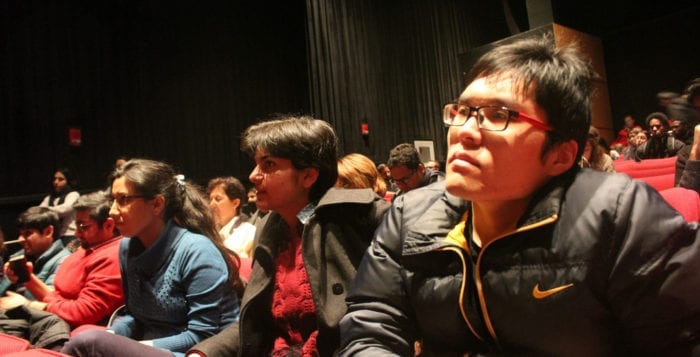SWAN SERENADE
A family of mute swans enjoy the peaceful, albeit chilly, waters of Stony Brook Harbor on Sunday, Feb. 12.
Photo by Heidi Sutton
Send your Photo of the Week to [email protected].
SWAN SERENADE
A family of mute swans enjoy the peaceful, albeit chilly, waters of Stony Brook Harbor on Sunday, Feb. 12.
Photo by Heidi Sutton
Send your Photo of the Week to [email protected].
By Geral Lee
Dr. Martin Luther King Jr. is unquestionably synonymous with Black History Month. He courageously confronted social inequities and racism in the midst of an adverse anti-black administration largely due to J. Edgar Hoover who had been appointed director of the Bureau of Investigation, renamed the Federal Bureau of Investigation in 1935. Few could compete with Hoover’s power and he went virtually unchallenged for half a century.
Hoover opposed making Dr. King’s birthday a national holiday. His smear campaign attempted to label Dr. King as a communist and a homosexual. He ordered illegal wire taps of Dr. King’s hotel room to try to justify his stance and used the power of government to satisfy his own bigotry toward blacks. Dr. King persevered.

There were many other individuals way before Dr. King who challenged the system in the name of justice. I am certain their actions helped define his political strategies. These people — and God bless them — were not just slaves, demonstrators or rioters.
I must include Glenn Beck in this article. I am not suggesting he is an authority on black history. As the colorful conservative that he is, his question as to why the many contributions of black people continue to remain hidden from the mainstream is a legitimate one — and yet another reason to celebrate Black History Month.
In one of his tapings, “Glenn Beck Founders’ Fridays Black American Founders” (Fox News), that I listened to on YouTube, he mentioned Peter Salem, a hero in the Battle of Bunker Hill who saved scores of American lives. During the Battle of Lexington, white and black parishioners who worshiped together were commanded to fight. James Armistead served as a double spy. And is that Prince Whipple, the black crewman, in the painting of George Washington crossing the Delaware? I am not so sure because many blacks fought in the American Revolution. Freedom was not an automatic option.
There have been unsung black heroes making all kinds of contributions throughout American history. The members of the 333rd Battalion, for example. The Chesapeake Marine Railway and Dry Dock Company of Baltimore, Maryland, which was one of the largest and most successful black businesses in America in the 1870s.
“Dirty Little Secrets About Black History: Its Heroes & Other Troublemakers” by Claud Anderson reveals that in the late 1800s, blacks invented and filed for patents on a number of transportation-related devices. Andrew J. Beared invented an automatic train car coupler. Albert B. Blackburn invented a railway signal. R.A. Butler invented a train alarm. Although many inventors were fresh out of slavery and the literacy rate among slaves was 50 percent, black inventors filed hundreds of patents for transportation devices. The Safe Bus Company was a black-owned city-chartered bus line in Winston-Salem, North Carolina, from 1930 to the 1960s.
Black history celebrates regular people engaged in positive activities. Here are some examples:
My father Herman Lee resided at 34 Christian Ave., Setauket, between 1956 and 2011. He was employed at the Setauket yard of the Brookhaven Highway Department in the 1960s and promoted to foreman in the 1970s. He did carpentry/home improvement projects for Three Village homeowners; among his regular clients, the Windrows and the Strongs. In World War II he served on the USS Hornet CV-12. After he became a chaplain for the VFW along with his wife Barbara Lewis Lee who was a practical nurse and historian in her own right. They sent all of their four children to college: Barbara, Herman, Geral and Peter.

Uncle Sherwood Lewis was an employee of Long Island Lighting Company (LILCO). He came up with an idea that saved the company more than $100,000 a year according to a Newsday article dated April 23, 1977. He, too, was raised on Christian Avenue and now resides in Massachusetts.
Grandmother Ethel Lewis, valedictorian of her high school graduating class, resided at 32 Christian Ave. with her husband Howard Lewis. They subdivided their property so my parents could build their house on Christian Avenue.
Aunt Hazel Lewis, salutatorian of her graduating class, was employed at Peck & Peck in New York City back in the day — a high-end boutique clothing store for women.
Aunt Pearl Lewis Hart received an associates degree in accounting in her 40s, was promoted to supervisor of the payroll department at SUNY Stony Brook and, until her death last month at age 92, was living in her own home on Christian Avenue.
Uncle Harry Hart, Pearl’s husband, owned his own excavation and contracting business from the 1940s to the 1980s. He acquired land on Christian Avenue and rented to many local folks.
Remembering a few of Dr. King’s principles of nonviolence can help provide the foundation for a healthy society: “Nonviolence is a way of life for brave people; attack problems, not people; know and do what is right even when it is difficult.”
I know there are many individuals who believe in these principles.
Black History Month means different things to different people, but if it can fill in the gaps, identify injustice, encourage positive dialogue and provide a platform for people to work toward understanding one another, it is a valuable ongoing process.
Geral Lee returned to her Setauket home in 2013 to be with her father after living in Rhode Island for 12 years. She taught physical education and health in Hempstead early in her career and received a personal invitation from her primary school coach Jack Foley, who later became athletic director for Three Village schools, to teach at Ward Melville. She served in the Peace Corps in Senegal, loves dogs and cats and currently relieves stress as a reflexologist.
By Daniel Dunaief
At first look, the connection between a roundworm, a zebrafish and cancer appears distant. After all, what can a transparent worm or a tropical fish native to India and the surrounding areas reveal about a disease that ravages its victims and devastates their families each year?
Plenty, when talking to David Matus and Benjamin Martin, assistant professors in the Department of Biochemistry and Cell Biology at Stony Brook University whose labs are next door to each other. The scientific tandem recently received the 2017 Damon Runyon–Rachleff Innovation Award, which includes a two-year grant of $300,000, followed by another renewable grant of $300,000 to continue this work.
In the first of a two-part series, Times Beacon Record Newspapers will profile the work of Matus this week. Next week the Power of Three will feature Martin’s research on zebrafish.
Long ago a scientist studying dolphin cognition in Hawaii, Matus has since delved into the world of genetic development, studying the roundworm, or, as its known by its scientific name, Caenorhabditis elegans. An adult of this worm, which lives in temperate soil environments, measures about 1 millimeter, which means it would take about 70 of them lined up end to end to equal the length of an average earthworm.

Matus specifically is interested in exploring how a cell called the anchor cell in a roundworm invades through the basement membrane, initiating a uterine-vulval connection that allows adult roundworms to pass eggs to the outside environment. He is searching for the signals and genetic changes that give the anchor cell its invasive properties.
Indeed, it was through a serendipitous discovery that he observed that the loss of a single gene results in anchor cells that divide but don’t invade. These dividing cells are still anchor cells, but they have lost the capacity to breach the basement membrane. That, Matus said, has led the team to explore the ways cancer has to decide whether to become metastatic and invade other cells or proliferate, producing more copies of itself. In some cancers, their hypothesis suggests, the cells either divide or invade and can’t do both at the same time. It could be a cancer multitasking bottleneck.
Mark Martindale, the director of the Whitney Laboratory at the University of Florida in Gainesville who was Matus’ doctoral advisor, said a cell’s decision about when to attach to other cells and when to let go involves cell polarity, the energetics of motility and a host of other factors that are impossible to study in a mammal.
The roundworm presents a system “in which it is possible to manipulate gene expression, and their clear optical properties make them ideal for imaging living cell behavior,” Martindale explained in an email. Seeing these developmental steps allows one to “understand a variety of biomedical issues.”
Last year, Matus and Martin were finalists for the Runyon–Rachleff prize. In between almost getting the award and this year, the team conducted imaging experiments in collaboration with Eric Betzig, a group leader at the Janelia Research Campus of the Howard Hughes Medical Institute in Ashburn, Virginia. Betzig not only brings expertise in optical imaging technologies but also has won a Nobel Prize.
“We really appreciate the opportunity to work with [Betzig] and his lab members on this project,” said Matus, who also published a review paper in Trends in Cell Biology that explored the link between cell cycle regulation and invasion. He and his graduate student Abraham Kohrman explored the literature to find cases that showed the same switching that he has been exploring with the roundworm.
Yusuf Hannun, the director of the Stony Brook Cancer Center, said the work is highly relevant to cancer as it explores fundamental issues about how cells behave when they invade, which is a key property of cancer cells. Hannun said the tandem’s hypothesis about division and invasion is “consistent with previous understandings but I believe this is the first time it is proposed formally,” he suggested in an email.
Their work could apply to invasive epithelial cancers, suggested Scott Powers, a professor in the Department of Pathology at Stony Brook and the director of Clinical Cancer Genomics at the Cancer Center. That could include breast, colon, prostate, lung and pancreatic cancers, noted Powers, who is a recent collaborator with Matus and Martin.
The additional funding allows Matus and Martin to focus more of their time on their research and less on applying for other grants, Matus said.

Matus lives in East Setauket with his wife Deirdre Killebrew, who works for Applied DNA Sciences. The couple met when they were working with dolphins in Hawaii. Matus’ first paper was on dolphin cognition, although he switched to evolutionary and developmental biology when he worked in Martindale’s lab at the University of Hawaii.
Martindale described Matus as prolific during his time in his lab, publishing numerous papers that were “profoundly important in our continued understanding of the relationship between genotype and phenotype and the evolution of biological complexity,” Martindale wrote in an email.
Following in Martindale’s footsteps, Matus replaced his middle name, Samuel, in publications with a Q. Martindale said several of his colleagues adopted the phony Q to pay homage to the attitude that drove them to pursue careers in science. Matus has now passed that Q on to Korhman, who is his first graduate student.
Matus and Killibrew have two daughters, Bria and Maille, who are 7 and 9 years old. Their children have a last name that combines each of their surnames, Matubrew. Matus said he feels “fortunate when I got here three years ago that they had me set up my lab next to [Martin]. That gave us an instantaneous atmosphere for collaboration.”


A commonly used cliché in sports is that teams always have to “take one game at a time.”
The Patriots head coach Bruce Haller said he thought his team was too focused on senior day ceremonies and the postseason, causing the girls to lose sight of their Feb. 11 matchup against Brentwood. If Ward Melville had won, the Patriots would be sharing a piece of the League I title, would have a higher seed and earn a second-round home playoff game. The 38-33 loss changed everything.
“It shows you that we are certainly not so good that we can just show up and win a game,” he said. “They have to come and be ready to play. We dug ourselves a deep hole, we came back, and the kids deserve a lot of credit for that, but I think it took so much energy to come back that we just didn’t have a lot left at the end of the game.”
Ward Melville fell behind 15-3 by the end of the first quarter, with all the Patriots points coming off of free throws. By halftime, senior Taylor Tripptree, junior Shannon Brazier and sophomore Lauren Hansen helped close the deficit just slightly, to 23-13. Hansen led in scoring with five points.

“We started off very slow,” Tripptree said. “We’re so used to playing after school and we have a different routine, so it brought us down. We had a kind of off practice last night and we tried not to let that show today, but they also came out hard, and we weren’t expecting it.”
The team turned it around in the third, with senior Hannah Lorenzen scoring the opening points on a three-pointer, and after Brentwood countered with a three-point shot of its own, Ward Melville went on a 10-0 tear to tie the game. Hansen added a field goal before swishing back-to-back threes, and Brazier scored off a feed from Tripptree to make it 26-26.
“[Coming back] shows that they have the potential and they’re capable of doing it, but they can’t turn it on and off,” Haller said. “They can’t decide to just struggle a little bit or miss a couple of shots and get down on themselves for missing their shots and all of the sudden turn it on later in the game.”
Triptree scored the opening point of the fourth quarter with a free throw at the 6:57 mark that gave the Patriots their first lead of the game, but a Brentwood bucket tied the game again, 29-29.

“We know not to give up,” Tripptree said. “We have to give 100 percent effort all the time. We are had workers.”
The two teams were knotted at 31 with less than five minutes left. Ward Melville fell behind 36-31, but two Lorenzen free-throws the Patriots within a single possession. Known for her three-point skills, Hansen attempted a shot with less than 30 seconds left, but just missed. The Patriots fouled on several straight Brentwood inbounds passes in an attempt to intercept the pass, but Brentwood was able to put the game away.
“I give Brentwood a lot of credit, they’re a playoff team,” Haller said. “They’re a very, very good team and we took them lightly. This was all on us.”

Despite the loss, the head coach said he thinks his team can go far.
“They’re great kids, they’re very good basketball players and I have confidence that they have the ability to make a deep run in the playoffs,” he said. “But if they come the way they came to play today they’ll be one and done in the playoffs.”
Tripptree said she also has confidence in her team’s ability to turn it around.
“We know we can’t let this bring us down,” she said. “Even if we have a bad practice, we know now we can’t let this bring us down or have it affect our game. We have to bring it — come hard every game — and we know we can pick it back up and put ourselves back in the game no matter how deep the hole is. We have to keep our heads up and expect anything in the playoffs.”
Committee created to start the process of creating family-oriented motorsports park

Suffolk County is putting the pedal to the metal in an effort to build a drag strip for its need-for-speed residents.
A large crowd of more than 100 drag racing enthusiasts filled the auditorium at the Suffolk County Legislature Feb. 7 and cheered on as Presiding Officer DuWayne Gregory (D-Amityville) announced the formation of an ad hoc committee, consisting of a bipartisan group of legislators, representatives from the Department of Planning and the Suffolk County Supervisors’ Association, and members from the racing community, to start the process of bringing a family-oriented motorsports park to the county.

“Long Island has thousands of families who are passionate about racing as a sport, and providing a legal outlet for drag racing could bring tremendous benefits to Suffolk County,” Gregory said during the press conference.
The ad-hoc committee was suggested by Suffolk County Legislator Tom Cilmi (R-Bay Shore) after representatives from the “L.I. Needs a Dragstrip” advocacy group charged into the legislature auditorium in December to protest a resolution on the board’s agenda.
The board had been considering a bill for a master plan in Yaphank, but the racing community argued against accepting the master plan, claiming that the property would be better used as a drag strip. The group had been looking at some areas included in the master plan for a potential site to build on. Even though the Yaphank property wound up not being anywhere near large enough for what they were proposing, the passionate group had the board’s interest.
“I was really inspired by the passion of all those that came to the Legislature and we’re going to do all we can to try and make it a reality,” Cilmi said in a phone interview.
In terms of the crowd at both gatherings, Cilmi said, “it’s worth pointing out that in the room were young children, lots of women and lots of guys … it was a large group of very enthusiastic people and it’s not every day that you fill an auditorium with people all interested in one issue.”
The Suffolk legislators on the committee —Gregory, Cilmi, Al Krupski (D-Cutchogue), and Rob Trotta (R-Fort Salonga) — will explore potential locations in Suffolk for the drag strip, which is projected to occupy between 100 and 200 acres, as well as the economic boom a full-fledged drag strip could bring to the struggling county.
“Long Island has thousands of families who are passionate about racing as a sport, and providing a legal outlet for drag racing could bring tremendous benefits to Suffolk County.”
—DuWayne Gregory
Gregory said the committee hopes the drag strip will deter the illegal and dangerous street racing that’s been known to take place in areas like Wyandanch. Another task is to make sure the local community and neighboring towns are behind the project and understand their quality of life will not be disrupted by it.
In building the drag strip, the committee anticipates growth in the local racing-related industry, like shops that paint the racing cars and work on engines, and job creation in those fields. There will also be food concessions within the arena, and spectators who could potentially come out and spend money at surrounding restaurants and hotels.
Gregory said any large venue has the potential to attract thousands of people and effectively increase the county’s sales tax, which has been flat for the last few years — “Long Island is losing money in sales tax as residents and tourists flock to nearby states, including New Jersey, to use their drag racing strips.” He said estimates show that a drag strip could generate more than $100 million in revenue.
He proposed that this would be “a safe and enjoyable attraction that people [will] want to come to.”
Kruspki, who grew up in Cutchogue and remembers his grandfather taking him to the Riverhead Raceway when he was young, said the racing culture is still very much alive.
“A lot of people are really interested in this and enjoy racing and working on cars and so to most people it’s more than a hobby, it’s more of a lifestyle,” he said in a phone interview. “I give DuWayne Gregory credit for putting this together; it’s a nice bipartisan group and everyone sees the value in it.”
While still too early to confirm any serious location ideas, the committee and members of the advocacy group have areas like Enterprise Park in Riverhead on a list of potential sites to build on. One of the motorsports advocates has expressed interest in contributing a piece of their own property.

“It’s going to be tough to find a spot to put this because a lot of people won’t want to hear it,” Trotta said in a phone interview. “It’s going to have to be somewhere far away from most people, but we’re going to try our utmost [best] to find a place.”
Trotta, who has been consistently vocal about Suffolk’s current economic state, said while he doesn’t necessarily believe the drag strip will be “a savior of Suffolk County,” there’s great potential to bring in needed revenue.
“There’s not a resort in Nassau or Suffolk, and Long Island is bigger than most cities,” Trotta said. “There’s an opportunity for us to make something and mix it with the drag strip. We need people from the city to come out here and spend money.”
During the press conference, John Cozzali, a Mastic resident and founder of “Long Island Needs a Drag Strip,” said he was happy to see the Legislature taking a serious look at his group’s long-dreamt project.
“We look forward to working on this initiative, which we believe will have a positive economic impact for Long Island and will create a safe place for the new generation to come and race,” Cozzali said.
According to Gregory, the full economic analysis, conceptual planning of the racetrack and location securing should take roughly nine months.
Two large German shepherd dogs attacked and killed a pet alpaca and severely injured a llama in a pen at the back of a home on Main Street in Setauket Feb. 5. It happened at about 2 a.m., according to Bob Ingram, a neighbor who witnessed the aftermath and found the dogs still at the scene.
“I heard barking coming from the pen,” the next-door neighbor Ingram said. “It was pitch black out and the barking was aggressive. Then I heard a shrill sound and knew one of the llamas was in distress.”
He drove his car onto the grass, toward the pen where he saw the two black-and-brown dogs menacing the llama. It was barely 10 minutes from the time he was awakened to the time he viewed the scene, he said. Ingram said he honked the horn, but the dogs just ignored it. Finally, he rolled down the car window and yelled and the dogs took off. Ingram called 911 and awaited police response. Upon arrival, an officer determined it necessary to euthanize the surviving animal.
The animals, 17-year-old Sasha the llama and Wookie, the alpaca, rescued eight years ago by Kerri Glynn, were beloved by many in the neighborhood.
“Llamas are such lovely animals,” Glynn said. “There’s not an aggressive bone in their bodies. We’d let them out [of the pen] in the backyard and they would never leave the property. They were the easiest animals to care for that I’ve ever owned.”
Ingram reached out on social media to alert Three Village residents of the danger posed by the dogs. The pen abuts the field at Setauket Elementary School, so he called to alert administrators there. He called his veterinarian, to spread the word.
In the wake of vicious maulings in Brookhaven Town last summer, the board unanimously approved a new policy Jan. 24, effective immediately, intended to keep a tighter leash on dangerous dogs and their owners.
“If there’s a message tonight, it’s to dog owners: Watch your dogs, protect them … and be a responsible owner … if you’re not, the town is putting things in place as a deterrent,” Brookhaven Town Supervisor Ed Romaine (R) said at the meeting.
Under the new town code amendment, which reflects stricter state law for dealing with “dangerous dogs,” the definition has been expanded to include not just dogs that attack people, as the code was previously written, but other pets or service animals as well.
Now the town, or the person attacked, can present evidence with regard to an attack before a judge or local animal control officers.
Owners of a dog deemed dangerous, who do not properly house their pets, will face large fines. A first-time offender of dog attacks will now pay $500 as opposed to a previous fine of $100; third-time offenders will pay up to $1,000 and must keep their dogs leashed, and in some cases, muzzled, when out in public.
After the Sunday attack, on social media people who travel along Mud Road, Quaker Path and Christian Avenue reported sightings of the two dogs dating back to January.
Save-a-Pet founder Dori Scofield said she had not received any calls about the dogs at either Save-a-Pet or Guardians of Rescue.
“German shepherds are super smart dogs,” Scofield said. “They’re going back to where they’re from.”
Area searches done since Sunday by local residents have not located the dogs.
Roy Gross, who heads the Suffolk County SPCA, said the organization had no knowledge of the Sunday morning incident.
Gross recommended a course of action should anyone see the dogs.
“Do not approach the dogs,” he said. “Dial 911 immediately, tell them you’ve sighted dogs matching the description of the ones that killed the pets on Main Street in Setauket, and give the location. If you are driving and can safely see where the dogs go, do so. A second call should be made to Brookhaven Animal Shelter (631-286-4940) to inform them of the location.”
He also gave advice to pet owners in the area.
“All animal owners should keep tabs on them — do not leave them out alone unattended,” he said, adding that is always good policy.
Ingram said he was devastated by the loss.
“I know these llamas really well,” he said. “They’ve been to my children’s birthday parties. Sasha was here when I moved in … [Those dogs] really scared me. A single person couldn’t handle those two dogs.”
Additional reporting by Kevin Redding.

During the month of February participating shops and restaurants in Stony Brook Village will thank and honor the service of our veterans by offering them special discounts, free coffee, dessert and more.
Veterans are asked to provide their veterans I.D. card to take part in the offers. If they do not have one, Joanne DeMarco, a representative from the Northport Veterans Administration, will be on hand at the Educational & Cultural Center in the rear of the Village Center on Wednesday, Feb. 15 from 10 a.m. to 3 p.m. to create and provide I.D. cards for them.
Offers from shops and restaurants include the Three Village Inn with a complimentary wine or local draft beer and the Country House Restaurant offering a free dessert with lunch or dinner. Mint Apparel, Chocolate Works, Crazy Beans, Stony Brook Auto Care and Latitude 121 Restaurant are offering 10 percent off; The Crushed Olive and Harbor Cleaners, 15 percent off; the MensRoom Barber and Blue Salon & Spa, 20 percent off; Crabtree & Evelyn will be giving free samples and Village Coffee Market will serve up free coffee with purchase; last but not least Roseland School of Dance is offering $20 off a 10-pack of Zumba classes.
For full details, visit www.stonybrookvillage.com or call 631-751-2244.
By Erika Riley
After a month-long break this holiday season, Stony Brook University’s Staller Center returns for the second half of its 2016-17 season with compelling performances. There is something for everybody, and you won’t want to miss out on these exciting shows.
“The second half of the Staller Center season really shows the diversity of our programs to fill the broad and varied tastes of our students, faculty, staff and greater community,” said Alan Inkles, director of Staller Center for the Arts. “Shows range from the world’s greatest violinist, Itzhak Perlman, to a spectacular cirque show, “Cuisine & Confessions” featuring aerealists, jugglers and acrobats and boasts a full kitchen where the cast cooks for our audience.
Inkles continued, “We truly span the arts in every format this spring. Bollywood’s finest song and dance routines will abound in Taj Express; Off Book/Out of Bounds with Brooklyn Rundfunk Orkestrata will add their pop/rock take on famous Broadway tunes; dance explodes as the Russian National Ballet Theatre brings a program with two story ballets, ‘Carmen’ and ‘Romeo & Juliet.’ The impeccable Martha Graham Dance Company brings their modern dance fire to Staller. Jazz abounds with award-winning artists including pianist Vijay Iyer and singer Cécile McLorin Salvant. There’s of course much more and with continued private and corporate support, we continue to keep ticket prices reasonable for everyone to attend and to attend often!”
Musical performances

On Feb. 19 at 7 p.m., Peter Kiesewalter, founder of the East Village Opera Company and Brooklyn Runkfunk Orkestrata, will be leading a high-energy rock show titled Off Book/Out of Bounds. The show, held in the Recital Hall, will feature a four-piece rock band performing rock versions of well-loved theater songs. Tickets are $42.
Grammy-nominated composer and pianist Vijay Iyer will be performing with his sextet in the Recital Hall on Feb. 25 at 8 p.m.. Described by The New Yorker as “jubilant and dramatic,” he plays pure jazz that is currently at the center of attention in the jazz scene. Tickets are $42.
The Staller Center’s 2017 Gala will take place on March 4 at 8 p.m. on the Main Stage and will feature violinist Itzhak Perlman. Perlman is the recipient of over 12 Grammys and several Emmys and worked on film scores such as “Schindler’s List” and “Memoirs of a Geisha.” Tickets are $75 and Gala Supporters can also make additional donations to enhance Staller Center’s programs and educational outreach activities.
Starry Nights returns to the Recital Hall on March 8 at 8 p.m. this year under the direction of Colin Carr, who will also be performing cello during the program. Artists-in-Residence at Stony Brook will be playing beautiful classics such as Vivaldi’s Violin Concerto and Schubert’s Piano Trio #3 in E flat major. Tickets are $38.

Newly added to the roster is singer, songwriter and pianist Peter Cincotti who will perform an intimate concert in the Recital Hall on March 9 at 8 p.m. Named “one of the most promising singer-pianists of the next generation” by the New York Times, Cincotti will be featuring his newest album, Long Way From Home. With a piano, a bench, a microphone and his band, Cincotti will take his audience on a breathtaking musical ride. Tickets are $30.
The Five Irish Tenors will be performing a lineup of beloved Irish songs and opera on March 18 at 8 p.m., the day after St. Patrick’s Day. Songs include “Down by the Sally Gardens,” “Will You Go Lassie Go” and “Danny Boy.” Tickets to the concert, taking place in the Recital Hall, are $42.
The award-winning Emerson String Quartet, with Eugene Drucker, Philip Setzer, Lawrence Dutton and Paul Watkins, will return on April 4 at 8 p.m. in the Recital Hall. The program will feature works by Dvorak, Debussy and Tchaikovsky. Tickets are $48.
Cecile McLorin Salvant will close out the musical performances of the season on April 29 at 8 p.m. in the Recital Hall with unique interpretations of blues and jazz compositions with the accompaniment of Sullivan Fortner on piano. Salvant is a Grammy award winner and has returned to the Staller Center after popular demand from her 2013 performance. The performance is sure to be theatrical and emotional. Tickets are $42.
Dance performances

Staller Center’s first dance performance of 2017 is sure to be a hit. Taj Express will be performing on Feb. 11 at 8 p.m., delivering a high-energy performance of Bollywood dances, celebrating the colorful dance and music of India. Through a fusion of video, dance and music, the ensemble will take you on a magical journey through modern Indian culture and society; this full-scale production will fuse east and west with classical dance steps, sexy moves and traditional silks and turbans. The extravagant performance will take place on the Main Stage, and tickets are $48.
The Russian National Ballet Theatre will be performing on the Main Stage on March 11 at 8 p.m. Created in Moscow, the Ballet Theatre blends the timeless tradition of classical Russian ballet with new developments in dance from around the world. The Ballet Theatre will be performing both “Carmen” and “Romeo & Juliet.” Tickets are $48.
Canada’s award-winning circus/acrobat troupe, Les 7 doigts de la main (7 Fingers of the Hand), will be performing their show Cuisine & Confessions on the Main Stage on April 1 (8 p.m.) and April 2 (2 p.m.) The show is set in a kitchen and plays to all five of the senses, mixing acrobatic cirque choreography and pulsating music with other effects, such as the scents of cookies baking in the oven, the taste of oregano and the touch of hands in batter. A crowd pleaser for all ages, tickets are $42.
The last dance performance of the season will be on April 8 at 8 p.m. by the Martha Graham Dance Company. The program will showcase masterpieces by Graham alongside newly commissioned works by contemporary artists inspired by Graham. The dance performance will take place on the Main Stage and tickets are $48.
Not just for kids

The ever unique Cashore Marionettes will be presenting a show called Simple Gifts in the Recital Hall on March 26 at 4 p.m. The Cashore Marionettes will showcase the art of puppetry through humorous and poignant scenes set to music by classics like Vivaldi, Beethoven and Copland. Tickets to see the engineering marvels at work are $20.
The Met: Live in HD
The Metropolitan Opera HD Live will be returning once again to the Staller Center screen. The screenings of the operas feature extras such as introductions and backstage interviews. There will be seven screenings throughout the second half of the season: “L’amour de Loin” on Jan. 14, “Romeo et Juliette” on Jan. 21, “Rusalka,” on Feb. 26, “La Traviata” on March 12, “Idomeneo” on April 9, “Eugene Onegin” on May 7 and “Der Rosenkavalier” on May 13. The screenings are all at 1:00 p.m., except for “Der Rosenkavalier,” which is at 12:30 p.m. For a full schedule and to buy tickets, visit www.stallercenter.com or call at 631-632-ARTS.
Films

As always, the Staller Center will be screening excellent films throughout the upcoming months. Through April 28, two movies will be screened on Friday evenings: one at 7 p.m. and one at 9 p.m. On Feb. 3, “Newtown,” a documentary about the Sandy Hook shooting, and “Loving,” a story of the first interracial marriage in America will both screen. “American Pastoral,” starring Ewan McGregor, Jennifer Connelly and Dakota Fanning will screen on Feb. 17; and “Jackie,” starring Natalie Portman, will screen on March 24. The season will finish off on April 28 with “Hidden Figures,” a true story of the African American female mathematicians who worked for NASA during the space race, and “La La Land,” a modern-day romantic musical starring Emma Stone and Ryan Gosling.
Tickets to the movie screenings are $9 for adults, $7 for students, seniors and children and $5 SBU students. Tickets for the shows and films may be ordered by calling 631-632-2787. Order tickets online by visiting www.stallercenter.com.
About the author: Stony Brook resident Erika Riley is a sophomore at Knox College in Galesburg, Illinois. She recently interned at TBR during her winter break and hopes to advance in the world of journalism and publishing after graduation.

Stony Brook University students, many of them international, poured into the Charles B. Wang Center on campus last week to voice their concerns and seek guidance following President Donald Trump’s (R) controversial executive order signed Jan. 27 which put a temporary freeze on travelers entering the United States from seven Muslim-majority nations.
A 19-year old student from Yemen, one of the seven countries targeted under the ban, said he’s afraid of being detained if he were to travel through John F. Kennedy International Airport for spring break. He asked not to be identified because of safety concerns.
A 24-year-old Muslim student from Bangladesh wanted to know if she’d be able to see her family this year.
A 22-year old student from Pakistan said he’s no longer interested in finding a physics job in the United States because, as he put it, “it’s just not an environment I want to be in.”
On Feb. 1, less than a week after Trump signed the order to ban citizens of the seven nations from entering the U.S. for 90 days, and all refugees for 120 days —the order has since been temporarily halted by a federal appeals court, though the U.S. Justice Department filed an appeal of the ruling — the university hosted an information session with two New York City-based immigration lawyers, Alexander Rojas and Eric Lorenzo of Barst Mukamal & Kleiner LLP.
According to Dr. Jun Liu, SBU’s Vice Provost for Global Affairs and Dean of International Academic Programs and Services, the session was organized by SBU President Dr. Samuel Stanley to affirm the university’s “commitment to diversity, strong values of inclusiveness, and campus environment that welcomes all.”
The legal experts addressed and interpreted the immigrant reform, which Rojas described as “startling,” as it stood on the day, and fielded questions from those in attendance. Representatives from the offices of Visa and Immigration Services and Dean of Students were also on hand to offer support and answer questions.
Rojas repeatedly advised students currently holding visas from any of the seven affected countries — Iran, Iraq, Libya, Somalia, Sudan, Syria and Yemen — to remain in the U.S. until the end of the 90-day period, April 27, because, as he said, “there is no guarantee that you’ll be allowed re-entry into the [U.S.].”
The three main student visas are F-1, H-1, and J-1, nonimmigrant visas for those studying, those in “specialized occupations,” and those wishing to take part in work-and-study-based exchange and visitor programs, respectively.
According to Lorenzo, the only type of visa excluded from the executive order are G-1, or diplomatic, visas, which are typically for representatives of foreign governments within the United Nations or foreign embassies within the U.S.
But Rojas, who acknowledged there’s still plenty of uncertainty hanging over the ban in terms of its function and development, said those within immigration law anticipate Trump might extend the 90-day period and implement considerations with regards to the countries listed, something the order already laid out as a possibility.
According to the lawyer, an unconfirmed draft with additional countries for the travel ban list had been circulating. The rumored additional countries, Rojas said, are Egypt, Lebanon, Afghanistan, Pakistan, Colombia, Venezuela, Philippines, and Mali.
“It would be prudent to not travel until there’s further guidance with regards to what the White House is going to do with respect to these additional countries proposed on that [supposed] list,” he said. Rojas added he’s not sure of the rationale behind any of the nations currently on the list, or the ones speculated to be in danger of being placed under similar restrictions.
The student from Bangladesh, who would only identify herself as Adrita, was told by Rojas that since her native country is not currently on the travel ban list, she should have no concerns about traveling back home to see her family.
While the 24-year-old genetics student admitted she’s glad to know she won’t be affected by the ban, she called the whole situation unfair.
“Even though I’m not from any of the affected countries, the ban seems to apply to Muslims…so obviously I’m concerned,” Adrita said. “Pakistan is one of the [possible] countries, and Pakistan is right next to Bangladesh. My parents told me ‘forget it, don’t travel, what if you’re told to come back to us?’ I’m doing a PhD here; I can’t just leave.”
Trump has insisted since the roll out of the order it’s not a Muslim ban but a security measure to prevent threats of terrorism.
“America has always been the land of the free and home of the brave,” the President said in a statement. “We will keep it free and keep it safe…to be clear, this is not a Muslim ban…this is not about religion — this is about terror and keeping our country safe.”
Daud Khan, 22, from Pakistan, said he anticipated this sort of situation upon Trump’s election.
“I was just home [in Pakistan] in December for my brother’s wedding and I made it a point to return before Trump’s inauguration so I arrived Jan. 19 to be on the safe side,” he said. “Because you don’t know what he’s going to do.”

In the wake of vicious dog maulings in the area, Brookhaven Town Board voted unanimously last week to adopt a new policy that will keep a tighter leash on dangerous dogs and their owners.
“If there’s a message tonight, the message is to dog owners: watch your dogs, protect them, protect them against other pets, and be a responsible owner because if you’re not, the town is putting things in place to act as a deterrent,” Brookhaven Town Supervisor Ed Romaine (R) said during the Jan. 24 town board meeting.
Under the new county code amendment, entitled “Dog Control and Animal Welfare,” which reflects the stricter state law for dealing with dangerous dogs, the definition of “dangerous dogs” has been changed to include not just dogs that attack people, as the code was previously written, but other pets or service animals as well.
Now the town, or the person who was attacked, can present evidence with regard to an attack before a judge or local animal control officers.
“I don’t think anyone who takes a long hard look at the facts of what happened last summer could possibly conclude that the existing town codes did enough to deter negligent dog owners.”
—Matt Tuthill
The owners of a dog deemed dangerous who do not properly house their pets will face large fines. A first-time offender of dog attacks will now pay $500 as opposed to a previous fine of $100, and third-time offenders will pay up to $1,000, and must keep their dogs leashed, and in some cases, muzzled, when out in public.
“It’s an attempt to place the onus on the owner,” Romaine’s chief of staff Emily Pines, who worked closely with town attorneys to craft the revised law, said during the meeting. “If the dog is going to be around in the neighborhood, the owner has a responsibility to keep the neighbors and other people in the community safe.”
The new policy comes after two incidents in Rocky Point last August wherein three loose pit bulls attacked and severely injured a woman and her boxer on a beach. Just a week later, the same pit bulls jumped over a fence onto a resident’s property and killed two Chihuahuas and injured their owner.
The pit bulls, which were returned following the first attack without penalty, were later euthanized by the town.
Rocky Point resident Matt Tuthill, who lives close to where the attacks occurred, spoke in support of the stricter rules on dog owners during the public hearing on the amendments.
Since the attacks last summer, Tuthill said he and his wife keep a knife in their 9-month-old son’s stroller whenever they take a walk around the neighborhood.
“It’s a huge concern to go outside with our son, and we even stopped going outside for a while,” Tuthill said. “I don’t think anyone who takes a long hard look at the facts of what happened last summer could possibly conclude that the existing town codes did enough to deter negligent dog owners. A loose dog that’s allowed to roam a neighborhood is as much a danger to other children and pets as it is to itself.”
He asked that dog owners in opposition to the proposed policy “please support common sense.”
Colin Goldberg, another Rocky Point resident, who founded the website Brookhaven Bites directly following the attack on his neighbor’s Chihuahuas, echoed Tuthill’s call for enforcement on dog owners.
“Let’s not forget that five dogs were killed,” Goldberg said. “If you care about the welfare of dogs, you will choose to support these changes as well as look more deeply into a real solution to this issue.”
“If the dog is going to be around in the neighborhood, the owner has a responsibility to keep the neighbors and other people in the community safe.”
—Emily Pines
Medford resident Rick Palomo said he’s been dealing with loose pit bulls and their negligent owners for the last few years. A year and a half ago, two pit bulls charged up his front deck and killed his cat, which he said was handicapped and “never had a chance” against the dogs. About two months ago, one of the pit bulls attacked and pinned down another cat of his, but his son was able to save it in time.
He said that with town’s previous policy of capturing dangerous dogs and releasing them back to the owner after a small fine, the dogs are back in the streets running rampant and “terrorizing the neighborhood” within days.
“We don’t know what to do; we finally set up traps in my backyard last Friday and police came and captured the dogs,” Palomo said. “We’re doing everything by the book … I’m afraid they’re going to kill a kid or attack somebody and really mess them up. We have to put a stop to it. I don’t want to see the dogs get killed.”
Palomo’s son, Joseph, said the pit bull owners would just laugh at the old legislation.
“It’s time to get legal action involved, they won’t listen to anybody anymore,” he said. “They said ‘Our dogs don’t bite people, they just don’t like cats,’ and that’s very evil.”
While none of the dangerous dog owners were present at the meeting to make a statement against the proposed codes, Laurette Richin, founder of Long Island Bulldog Rescue, told board members that creating strict laws is not the solution.
“I’ve been rescuing and placing bulldogs and pit bulls in [the Town of Brookhaven] for 17 years and I think people need to be responsible with each other and mind their neighborhood by reporting these things,” Richin said. “I don’t think this should be legislated more.”
In response, Councilman Michael Loguercio (R-Middle Island) said that “sometimes you have to pass a law to protect people from themselves, so not only does this law emulate the state’s law but it helps protect the dog owners as well.”
The new policy will be in effect immediately.
